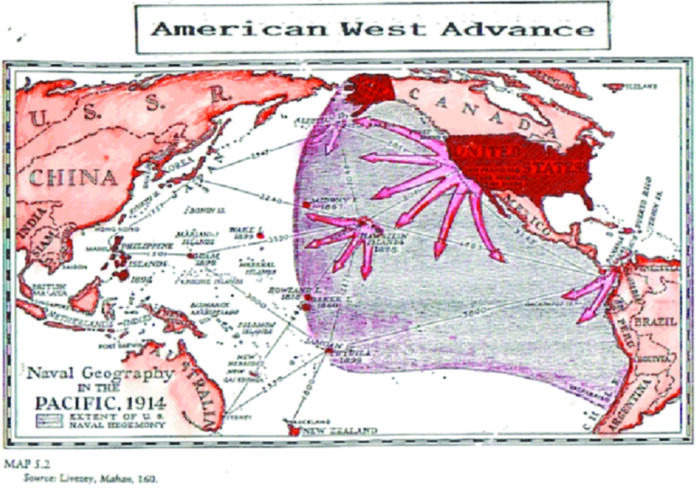Geopolitics is the study of the relationship between geography, politics, and international relations. It focuses on how geographic factors, such as land, water, resources, and population, influence political decision-making and international power dynamics. There are several theories of geopolitics that attempt to explain the relationship between geography and politics.
The Rim land theory is a geopolitical theory proposed by American political scientist Nicholas Spykman in the 1940s. The theory argues that the coastal regions surrounding the Eurasian landmass, known as the Rim land, are the most important geopolitical regions in the world. Spykman believed that whoever controls the Rim land would be able to contain the power of the Heartland, which refers to the central region of Eurasia, as proposed by the Heartland theory of Halford Mackinder. Spykman argued that the Rim land was strategically more important than the Heartland because it had greater access to the sea and could control global trade and commerce. The Rim land includes Europe, the Middle East, and East Asia, and is characterized by a high population density, abundant resources, and diverse cultures. Spykman believed that the Rim land was a key geopolitical battleground because it was the buffer zone between the Heartland and the sea.
According to Spykman, the United States had a vital interest in controlling the Rim land because it was the only way to prevent the Soviet Union from dominating Europe and Asia. He argued that the United States should support the development of democratic states in the Rim land and provide economic and military assistance to contain Soviet influence. The Rim land theory was influential in shaping US foreign policy during the Cold War and continues to be relevant today in discussions about the role of the United States in the Middle East and East Asia. However, the theory has been criticized for oversimplifying the complex geopolitical dynamics of the region and underestimating the importance of other factors, such as ideology and culture.
The United States implemented a strategy of containment, which aimed to prevent the spread of Soviet influence by supporting democratic states in the Rim land and providing economic and military assistance to contain Soviet influence. The US also engaged in numerous conflicts and interventions in the Rim land region, including the Korean War, the Vietnam War, and various Middle Eastern conflicts, to protect its strategic interests and prevent Soviet expansion.
Even after the end of the Cold War, the United States continues to have strategic interests in the Rim land, particularly in the Middle East and East Asia. The US has maintained a military presence in the region and has engaged in various military interventions and operations, including the Gulf War, the Iraq War, and the War in Afghanistan. These actions have been justified on the grounds of protecting US strategic interests and promoting stability and democracy in the region. The United States has had a significant interest in controlling the Rim land, both during the Cold War and in the present day, due to its strategic importance in global trade and commerce, as well as its role as a buffer zone between great powers.
According to Spykman, the United States had a vital interest in controlling the Rim land because it was the only way to prevent the Soviet Union from dominating Europe and Asia.
The Rim land theory has also been applied to China in various ways. Some scholars argue that China’s rise as a major global power has shifted the balance of power in the Rim land, particularly in East Asia, and that China’s control of strategic sea routes in the region poses a challenge to US strategic interests.
China’s growing economic and military influence in the region has led some analysts to suggest that China is seeking to establish hegemony in the Rim land. China’s Belt and Road Initiative (BRI), which aims to promote economic connectivity across Eurasia and beyond has been seen as a way to expand Chinese influence and control over key trade routes and infrastructure in the Rim land. Others argue that China’s rise may lead to a realignment of power in the Rim land, with countries in the region seeking to balance against Chinese influence by aligning with the United States or other powers. Some scholars also suggest that China’s focus on its own domestic development and internal stability may limit its ability to project power and influence beyond its borders. The BRI is a massive infrastructure and investment program that seeks to connect China with other regions of the world through a network of railways, highways, ports, and pipelines. The initiative includes investments in numerous countries in the Rim land region, including Southeast Asia, South Asia, Central Asia, and the Middle East. Some analysts argue that China’s investments in the Rim land are part of a broader strategy to establish a sphere of influence in the region and gain control over strategic sea lanes and resources. The BRI has been criticized by some countries and analysts for creating debt traps and advancing China’s strategic interests at the expense of other countries. However, others argue that China’s investments in the Rim land are driven by economic interests and a desire for regional stability and development. Chinese officials have stated that the BRI is an inclusive initiative that seeks to promote cooperation and mutual benefits among participating countries. The Rim land theory provides a useful framework for understanding China’s strategic interests and geopolitical position in the region. As China is continuing to rise as a global power, its influence in the Rim land will likely remain a key concern for policymakers and analysts alike.
Other countries, such as Russia and various European powers have also been influenced by the Rim land theory to varying degrees. For example, Russia has historically sought to expand its influence in the Rim land by establishing alliances and controlling strategic ports in the region, while China has sought to increase its influence in the Rim land through its Belt and Road Initiative, which aims to develop infrastructure and trade routes in the region.























